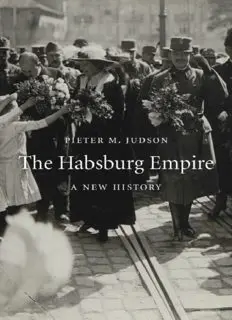
The Habsburg Empire: A New History PDF
Preview The Habsburg Empire: A New History
The Habsburg Empire A New History PIETER M. JUDSON The Belknap Press of Harvard University Press CAMBRIDGE, MASSACHUSETTS LONDON, ENGLAND . 2016 . Copyright © 2016 by the President and Fellows of Harvard College All rights reserved Design by Dean Bornstein Jacket credit: © Österreichische Nationalbibliothek Jacket designer: Annamarie McMahon Why 978-0-674-04776-1 (cloth) 978-0-674-96932-2 (EPUB) 978-0-674-96933-9 (MOBI) The Library of Congress has cataloged the printed edition as follows: Names: Judson, Pieter M., author. Title: The Habsburg empire : a new history / Pieter M. Judson. Description: Cambridge, Massachusetts : The Belknap Press of Harvard University Press, 2016. | Includes bibliographical references and index. Identifiers: LCCN 2015036845 Subjects: LCSH: Habsburg, House of—History. | Nationalism—Europe, Central—History. | Imperialism— Social aspects—Europe, Central—History. Classification: LCC DB36.3.H3 J83 2016 | DDC 943.6/04—dc23 LC record available at http://lccn.loc.gov/2015036845 FOR CHARLES CONTENTS Note on Names and Places List of Maps and Illustrations Introduction 1. The Accidental Empire 2. Servants and Citizens, Empire and Fatherland, 1780–1815 3. An Empire of Contradictions, 1815–1848 4. Whose Empire? The Revolutions of 1848–1849 5. Mid-Century Modern: The Emergence of a Liberal Empire 6. Culture Wars and Wars for Culture 7. Everyday Empire, Our Empire, 1880–1914 8. War and Radical State-Building, 1914–1925 Epilogue: The New Empires Notes Acknowledgments Index NOTE ON NAMES AND PLACES The subject of this book is a state that was known by many different names over the period 1770–1918. I refer to this state as the Habsburg Monarchy or Habsburg Empire. From 1804 until 1867 the state was known as the Austrian Empire. After the Settlement of 1867 the new dual monarchy was called Austria- Hungary. I refer to the western half of the dual monarchy as Austria, even though its official name was not Austria but rather “The Kingdoms and Lands Represented in the Parliament [Reichsrat]” (sometimes referred to as “Cisleithania,” while Hungary became “Transleithania”). Writing about Habsburg central Europe in a way that does not reinforce a nationalist frame of reference is next to impossible. In recognition of this challenge, I try to refer to places with no common English names in the two or three languages their inhabitants used to name them. This practice may seem a cumbersome one, and nationalists may dispute the order in which I list those names, but it helps to challenge the assumptions that each of these places had a single authentic national identity. For places with common English names such as Cracow, Prague, Trent, or Vienna, I use the English version. I try to avoid using normative terms like “Czechs,” “Germans,” “Poles,” or “Slovenes,” preferring instead descriptive terms like “Czech speakers,” even though this practice does not adequately describe the linguistic practices of many of its peoples. It does, however, return a modicum of agency to people who are otherwise often categorized in ways they might not have recognized. I use the term “Hungarian” and “Hungarianization” in places where others might use “Magyar” and “Magyarization.” Some scholars distinguish between a state- based concept of nation (Hungary) and a more ethnically inflected concept (Magyar), but this fundamental distinction makes little intellectual sense to me, especially in the context of the nineteenth century. For reasons of historical context I generally use the terms “Ruthene” and “Ruthenian” to denote the peoples and language that today are generally known as Ukrainian, although it is the case that by 1900 the term Ukrainian was becoming used more widely. Except where cited in English-language works by other authors, all translations are my own. LIST OF MAPS AND ILLUSTRATIONS Maps Habsburg Territories at the end of the War of the Austrian Succession, 1748 Habsburg Territories in 1772 The Austrian Empire in 1815 after the Congress of Vienna The Austrian Empire, 1859–1867 Austria-Hungary in 1914 Austria-Hungary with wartime Polish and Balkan Zones of Occupation East Central Europe in 1925 Illustrations Remains of the Habsburg castle in Canton Aargau, Switzerland Maria Theresa and her children in 1776 View of Trieste’s / Trst’s very busy harbor in the eighteenth century Nineteenth-century depiction of Joseph II taking a turn at the plow in Slavíkovice Moravia Maria Theresa’s son Grand Duke Leopold of Tuscany, later Emperor Leopold II, surrounded by his family in Florence The Departure of the Militiaman (1813) by Johann Peter Krafft Johann Peter Krafft’s depiction of the triumphant return of Emperor Franz I to Vienna An Austrian steamship of the mid-nineteenth century arriving in Trieste / Trst The railway bridge leading to Brünn / Brno, with the city in the distance View of Troppau / Opava The port of Zadar / Zara in Dalmatia, ca. 1845 Emperor Ferdinand on 15 March 1848, acclaimed by an enthusiastic Viennese crowd after his promise of a constitution Nineteenth-century engraving depicting the Venetian uprising Depiction of the first uncensored newspapers sold in the streets of Vienna in 1848 The Hungarian Parliament votes to create a military force to fight the invading army of Ban Joseph Jelačić František Palacký (1798–1876), noted historian of the Bohemian Lands and political leader of the Czech nationalist movement Minister of Justice and of the Interior Alexander von Bach (1813–1893) Photograph from an album commemorating the completion of the Südbahn railway line in 1857 Empress Elisabeth of Austria on horseback, one of her favorite activities The imperial family in 1860 Ferenc Deák (1803–1876) in mid-life Francis Joseph and Elisabeth after their coronation as King and Queen of Hungary Cartoon in the satirical magazine Kikeriki, 9 January 1868
